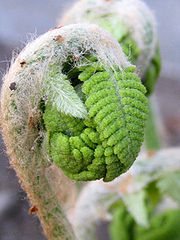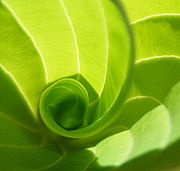
Vernation
Encyclopedia
Vernation is the formation of new leaves
or frond
s. In plant anatomy, it is the arrangement of leaves in a bud
.
In pine trees new leaves are short and encased in sheaths. Each leaf bundle consists of 2 to 5 needles. All the leaves on one section of branch grow in length together. In the cabbage
, new leaves are folded over, each covered by the previous leaf.
 Circinate vernation is the manner in which a fern
Circinate vernation is the manner in which a fern
frond emerges. As the fern frond is formed, it is tightly curled so that the tender growing tip of the frond (and each subdivision of the frond) is protected within a coil. At this stage it is called a crozier (after the shepherd
's crook) or fiddlehead
(after the scrollwork
at the top of a violin). As the lower parts of the frond expand and toughen up, they begin to photosynthesize
, supporting the further growth and expansion of the frond. In the case of many fronds long hairs or scales provide additional protection to the growing tips before they are fully uncoiled. Circinate vernation may also be observed in the extension of leaflet
s, in the compound leaves of Cycads. Circinate vernation is also typical of the carnivorous plant family Droseraceae
, for example see this photo of Drosera filiformis
.
 The process of convolute vernation involves the wrapping of one margin of the leaf's blade over the other. This folding mechanism makes the emerging leaf look like a tube.
The process of convolute vernation involves the wrapping of one margin of the leaf's blade over the other. This folding mechanism makes the emerging leaf look like a tube.
Leaf
A leaf is an organ of a vascular plant, as defined in botanical terms, and in particular in plant morphology. Foliage is a mass noun that refers to leaves as a feature of plants....
or frond
Frond
The term frond refers to a large, divided leaf. In both common usage and botanical nomenclature, the leaves of ferns are referred to as fronds and some botanists restrict the term to this group...
s. In plant anatomy, it is the arrangement of leaves in a bud
Bud
In botany, a bud is an undeveloped or embryonic shoot and normally occurs in the axil of a leaf or at the tip of the stem. Once formed, a bud may remain for some time in a dormant condition, or it may form a shoot immediately. Buds may be specialized to develop flowers or short shoots, or may have...
.
In pine trees new leaves are short and encased in sheaths. Each leaf bundle consists of 2 to 5 needles. All the leaves on one section of branch grow in length together. In the cabbage
Cabbage
Cabbage is a popular cultivar of the species Brassica oleracea Linne of the Family Brassicaceae and is a leafy green vegetable...
, new leaves are folded over, each covered by the previous leaf.
Circinate vernation

Fern
A fern is any one of a group of about 12,000 species of plants belonging to the botanical group known as Pteridophyta. Unlike mosses, they have xylem and phloem . They have stems, leaves, and roots like other vascular plants...
frond emerges. As the fern frond is formed, it is tightly curled so that the tender growing tip of the frond (and each subdivision of the frond) is protected within a coil. At this stage it is called a crozier (after the shepherd
Shepherd
A shepherd is a person who tends, feeds or guards flocks of sheep.- Origins :Shepherding is one of the oldest occupations, beginning some 6,000 years ago in Asia Minor. Sheep were kept for their milk, meat and especially their wool...
's crook) or fiddlehead
Fiddlehead
Fiddleheads or Fiddlehead greens are the furled fronds of a young fern, harvested for use as a vegetable. Left on the plant, each fiddlehead would unroll into a new frond...
(after the scrollwork
Scrollwork
Scrollwork is an element of ornamentation and graphic design using a spiral. The name comes from by the supposed resemblance to the edge-on view of a rolled parchment scroll. "Scrollwork" is today mostly used in popular language for two-dimensional decorative flourishes and arabesques of all...
at the top of a violin). As the lower parts of the frond expand and toughen up, they begin to photosynthesize
Photosynthesis
Photosynthesis is a chemical process that converts carbon dioxide into organic compounds, especially sugars, using the energy from sunlight. Photosynthesis occurs in plants, algae, and many species of bacteria, but not in archaea. Photosynthetic organisms are called photoautotrophs, since they can...
, supporting the further growth and expansion of the frond. In the case of many fronds long hairs or scales provide additional protection to the growing tips before they are fully uncoiled. Circinate vernation may also be observed in the extension of leaflet
Leaflet
A leaflet in botany is a part of a compound leaf. A leaflet may resemble an entire leaf, but it is not borne on a stem as a leaf is, but rather on a vein of the whole leaf. Compound leaves are common in many plant families...
s, in the compound leaves of Cycads. Circinate vernation is also typical of the carnivorous plant family Droseraceae
Droseraceae
Droseraceae is the botanical name for a family of flowering plants. The family is also known under its common name, the sundew family.It consists of carnivorous plants: besides the sundews, the genus Drosera, it also contains the even more-famous Venus fly trap Dionaea muscipula...
, for example see this photo of Drosera filiformis
Drosera filiformis
Drosera filiformis, commonly known as the Thread-leaved sundew, is a small, insectivorous, rosette forming species of perennial herb. A species of sundew, it is unusual within its genus in that the long, erect, filiform leaves of this plant unroll in spirals - an arrangement similar to the...
.
Convolute vernation

Involute vernation
In involute vernation both margins on opposing sides of the leaf are rolled up forming two tubes that meet at the midrib of the leaf.See also
- AestivationAestivation (botany)Aestivation or estivation, refers to the positional arrangement of the parts of a flower within a flower bud before it has opened. Aestivation is also sometimes referred to as praefoliation or prefoliation, but these terms may also mean vernation: the arrangement of leaves within a vegetative...
— the way in which the petalPetalPetals are modified leaves that surround the reproductive parts of flowers. They often are brightly colored or unusually shaped to attract pollinators. Together, all of the petals of a flower are called a corolla. Petals are usually accompanied by another set of special leaves called sepals lying...
s and sepalSepalA sepal is a part of the flower of angiosperms . Collectively the sepals form the calyx, which is the outermost whorl of parts that form a flower. Usually green, sepals have the typical function of protecting the petals when the flower is in bud...
s of a flower are arranged in a bud. - Ptyxis — the way an individual leaf is folded within a bud.

